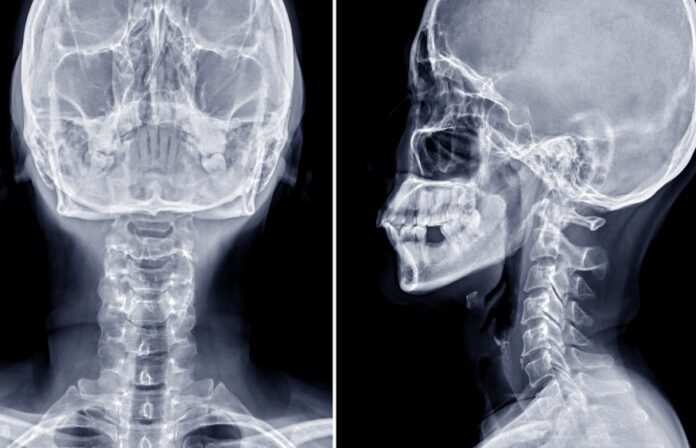In September 2022, a tragic and medically unprecedented case shook both the orthopedic and workplace safety communities. An 18-year-old laborer in India suffered a catastrophic cervical spine injury when a heavy metallic object fell directly on the front of his head while he was working. The incident, documented in the Journal of Orthopaedic Case Reports, not only led to his death within 48 hours but also revealed a spinal fracture pattern so rare that it does not fit any existing classification system.
This is more than a heartbreaking story. It’s a wake-up call about how devastating even a single moment of oversight in a work environment can be—and how our medical tools may still fall short when it comes to the unexpected.
A Routine Workday Turns Tragic
On what seemed like a typical day on the job, the young man was standing in his work zone when disaster struck. A heavy metallic pipe or beam fell from above, slamming into the front of his head—not the top or back, which is more common in trauma cases, but squarely on the forehead.
The blow caused instant loss of consciousness. Within moments, the teen fell into respiratory distress, shock, and hemodynamic instability. Emergency responders acted quickly. They intubated him on-site, applied a rigid cervical collar, and transferred him to the nearest hospital. Despite these efforts, he passed away two days later, unable to recover from the massive trauma.
This was not just a devastating injury. It was a medical mystery.
Inside the Injury: A Fracture That Defies the Textbooks
A non-contrast CT scan revealed something never before published in any spine classification manual:
-
- The C5 vertebral body had suffered a retropulsion fracture, meaning it had collapsed and pushed backward into the spinal canal.
- A secondary fracture was visible in the upper back portion of the C6 vertebra.
- Yet remarkably, there was no damage to the facet joints or pedicles, which are usually compromised in injuries this severe.
This created a “nutcracker-like” effect—a brutal compression between vertebrae, where the C5 was literally crushed and forced backward into the spinal canal. The result: direct compression of the spinal cord, which explained the young man’s rapid deterioration.
What’s particularly shocking is that this injury doesn’t fit into any of the established spinal injury classification systems, such as:
-
- Allen & Ferguson
- SLIC-S (Subaxial Injury Classification System)
- AO Spine classification
It was, quite simply, an anomaly—one that now calls for broader diagnostic models and expanded recognition of atypical trauma mechanics.
The Biomechanics: How Did This Happen?
The subaxial cervical spine (C3 to C7) is responsible for most of the neck’s motion. But that mobility makes it vulnerable to vertical impact.
In this case, the frontal blow sent axial force downward, forcing C5 to absorb the brunt of the energy. Unlike more common cervical fractures, which typically involve side impacts or hyperflexion, this was a pure vertical flexion-compression injury.
Think of it like a vice grip squeezing the vertebra between C4 and C6. The pressure was so intense, it crushed the vertebral body backward into the spinal canal. That internal damage disrupted the spinal cord almost immediately—explaining the victim’s collapse, breathing difficulties, and eventual organ failure.
The Medical Response and Outcome
Upon hospital arrival, the patient was already severely compromised:
-
- He required ventilator support and cervical traction.
- Despite stabilization, his neurological and respiratory functions continued to decline.
- The injury’s severity and the unstable condition ruled out surgical intervention.
Despite rapid and appropriate emergency care, the trauma was simply too catastrophic to overcome. The young man died two days later, a tragic reminder of how fragile the human spine can be—and how time is critical in these injuries.
Why This Case Matters
This is more than an isolated tragedy. It’s a medically and socially significant event, highlighting several key takeaways:
1. Workplace Accidents Can Have Catastrophic Outcomes
Even one unsecured object—one moment of inattention—can lead to irreversible trauma. Safety in industrial and construction settings must be non-negotiable, especially when workers operate under suspended loads or in environments with overhead hazards.
2. Spinal Trauma Classification Systems Have Gaps
The current tools used by orthopedic surgeons, radiologists, and trauma teams failed to classify this injury. That gap could lead to misdiagnosis or improper treatment plans in other, similarly rare cases.
This underscores the need for more inclusive, flexible classification systems that can accommodate injuries outside the norm.
3. Emergency Response Can Only Do So Much
Even with fast intervention—intubation, spinal support, traction—some injuries simply exceed what medicine can reverse. That reality places even greater importance on prevention over treatment.
Prevention: What Could Have Saved Him
This case provides a checklist of critical safety measures that could help avoid similar tragedies:
Occupational Safety Best Practices
-
- Always wear certified safety helmets in zones where falling objects are a risk.
-
- Never work directly under suspended loads—even briefly.
- Use proper overhead storage systems, including straps, nets, or solid barriers.
- Employers must train workers thoroughly on recognizing and avoiding potential falling hazards.
At-Home Prevention Tips
-
- Anchor tall furniture to walls.
- Avoid placing heavy items on top shelves that children or adults could pull down.
- Educate family members about basic spinal injury risks from falling objects.
What Medical Professionals Need to Know
-
- Don’t rely solely on standard injury patterns.
Just because facet joints or pedicles are intact doesn’t mean the spinal canal is safe. - Always use comprehensive imaging (CT, and MRI when available) to assess spinal damage.
- Document and report unusual cases. Only through shared learning can the medical community adapt and evolve classification systems.
- Don’t rely solely on standard injury patterns.
A Young Life, A Lasting Impact
This 18-year-old man’s life ended far too soon, the victim of an unpredictable yet preventable workplace incident. But his story now serves a broader purpose: prompting conversations in occupational safety, exposing limitations in spine injury diagnostics, and reminding all of us—whether employers, doctors, or workers—how quickly things can go wrong.
In medicine, not every case fits the mold. In life, not every tragedy can be undone. But with awareness, education, and stronger systems in place, we can work to ensure stories like this one become increasingly rare.
Because every worker—no matter how young, how new, or how routine the task—deserves to return home safely.




